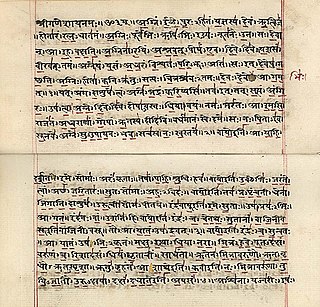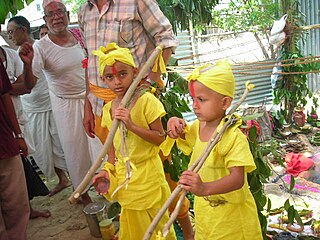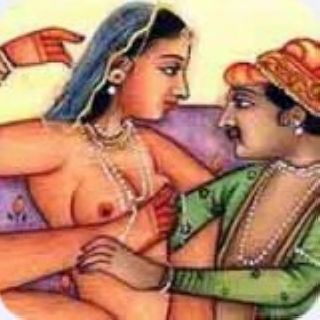Smriti, literally "that which is remembered" are a body of Hindu texts usually attributed to an author, traditionally written down but constantly revised, in contrast to Śrutis considered authorless, that were transmitted verbally across the generations and fixed. Smriti is a derivative secondary work and is considered less authoritative than Sruti in Hinduism, except in the Mimamsa school of Hindu philosophy. The authority of smriti accepted by orthodox schools, is derived from that of shruti, on which it is based.

Upanayana is one of the traditional saṃskāras that marked the acceptance of a student by a guru (teacher) and an individual's entrance to a school in Hinduism. The tradition is widely discussed in ancient Sanskrit texts of India and varies regionally. The sacred thread is received by the boy during this ceremony, that he continues wearing across his chest thereafter.
Grihastha literally means "being in and occupied with home, family" or "householder". It refers to the second phase of an individual's life in a four age-based stages of the Hindu ashram system. It follows Brahmacharya life stage, and embodies a married life, with the duties of maintaining a home, raising a family, educating one's children, and leading a family-centred and a dharmic social life.

Sannyasa is the life stage of renunciation within the Hindu philosophy of four age-based life stages known as ashramas, with the first three being Brahmacharya, Grihastha (householder) and Vanaprastha. Sannyasa is traditionally conceptualized for men or women in late years of their life, but young brahmacharis have had the choice to skip the householder and retirement stages, renounce worldly and materialistic pursuits and dedicate their lives to spiritual pursuits.

The Yajurveda is the Veda primarily of prose mantras for worship rituals. An ancient Vedic Sanskrit text, it is a compilation of ritual offering formulas that were said by a priest while an individual performed ritual actions such as those before the yajna fire. Yajurveda is one of the four Vedas, and one of the scriptures of Hinduism. The exact century of Yajurveda's composition is unknown, and estimated by scholars to be around 1200 to 1000 BCE, contemporaneous with Samaveda and Atharvaveda.
Dharmaśāstra is a genre of Sanskrit theological texts, and refers to the treatises (shastras) of Hinduism on dharma. There are many Dharmashastras, variously estimated to be 18 to about 100, with different and conflicting points of view. Each of these texts exist in many different versions, and each is rooted in Dharmasutras texts dated to 1st millennium BCE that emerged from Kalpa (Vedanga) studies in the Vedic era.
Vrata is a Sanskrit word that means "vow, resolve, devotion", and refers to pious observances such as fasting and pilgrimage (Tirtha) found in Indian religions such as Jainism and Hinduism. It is typically accompanied with prayers seeking health and happiness for their loved ones.

Pandurang Vaman Kane was a notable Indologist and Sanskrit scholar. He received India's highest civilian award Bharat Ratna in 1963 for his scholarly work that spanned more than 40 years of active academic research that resulted in 6,500 pages of History of Dharmaśāstra. The historian Ram Sharan Sharma says: "Pandurang Vaman Kane, a great Sanskritist wedded to social reform, continued the earlier tradition of scholarship. His monumental work entitled the "History of the Dharmasastra", published in five volumes in the twentieth century, is an encyclopedia of ancient social laws and customs. This enables us to study the social processes in ancient India."
The History of Dharmaśāstra, with subtitle Ancient and Medieval Religious and Civil Law in India, is a monumental five-volume work consisting of around 6,500 pages. It was written by Pandurang Vaman Kane, an Indologist. The first volume of the work was published in 1930 and the last one in 1962. The work is considered Kane's magnum opus in English.
The Mitākṣarā is a vivṛti on the Yajnavalkya Smriti best known for its theory of "inheritance by birth." It was written by Vijñāneśvara, a scholar in the Western Chalukya court in the late eleventh and early twelfth century. Along with the Dāyabhāga, it was considered one of the main authorities on Hindu Law from the time the British began administering laws in India. The entire Mitākṣarā, along with the text of the Yājñavalkya-smṝti, is approximately 492 closely printed pages.

Sanskara are rites of passage in a human being's life described in ancient Sanskrit texts, as well as a concept in the karma theory of Indian philosophies. The word literally means "putting together, making perfect, getting ready, to prepare", or "a sacred or sanctifying ceremony" in ancient Sanskrit and Pali texts of India.

Pumsavana is the second of the 16 saṃskāras in ancient texts of Hinduism. The rite of passage is celebrated in the third or fourth month of pregnancy, typically after the pregnancy begins to show but before the baby begins to move in the womb.

Svādhyāya is a Sanskrit term which literally means "one's own reading" and "self-study". It is also a broader concept with several meanings. In various schools of Hinduism, Svadhyaya is a Niyama connoting introspection and "study of self". The term also means the self-study and recitation of the Vedas and other sacred books.

Garbhadhana is the first of the 16 saṃskāras in Hinduism.

Jatakarman is one of the major samskaras in Hinduism, that celebrates the birth of a child. It is typically a private rite of passage that is observed by the new parents, relatives of the baby and close friends.

Namakarana is the naming ceremony in Hinduism and a Sanskara to name a baby.
Simantonnayana is the third of the 16 saṃskāras in the ancient texts of Hinduism. It is observed in the last trimester of pregnancy to wish for safe delivery and is similar to a baby shower.

Tagadhari is a Nepalese Hindu social group that is historically perceived with high socio-religious status. Members of the group wears the sacred thread (Janai), a holy thread used for ritualistic purpose in Hinduism, around their torso. The sacred thread has been shown in the Nepalese society as a mark of high socio-religious status. The sacred thread called yajñopavītam in Sanskrit and Janai in Nepali, is received after the Upanayana ceremony.













